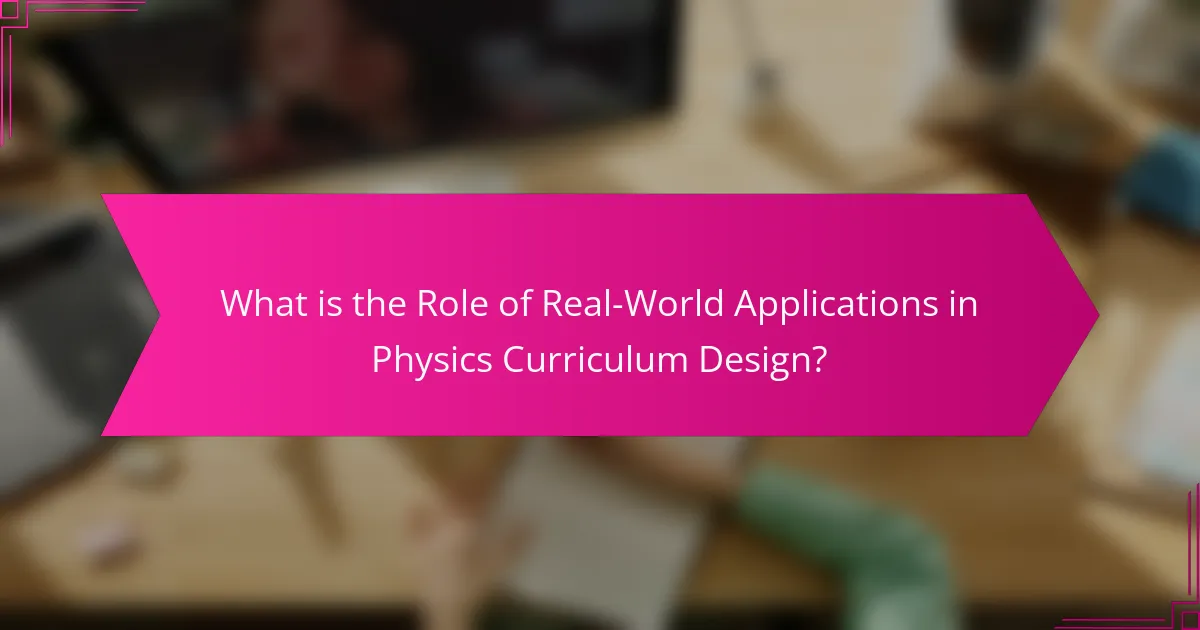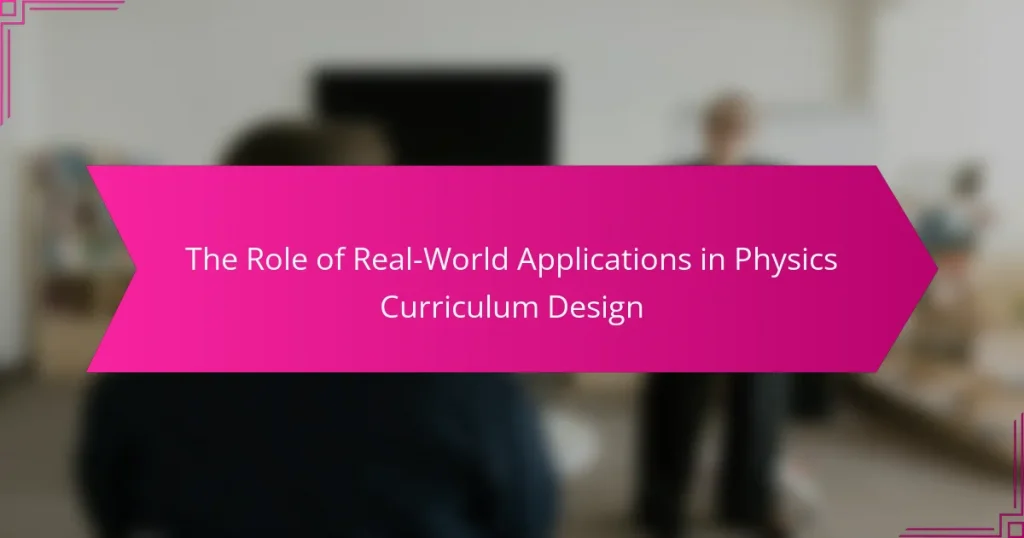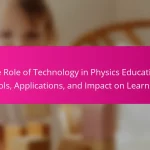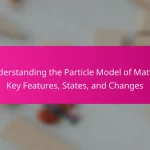Real-world applications are essential in the design of physics curricula, as they significantly enhance student engagement by linking theoretical concepts to practical experiences. By incorporating examples such as renewable energy sources and medical imaging, students gain a clearer understanding of physics’ relevance in everyday life. Research indicates that contextual learning not only improves knowledge retention but also enhances problem-solving skills and fosters critical thinking. Integrating these applications prepares students for future careers in science and technology, ultimately inspiring innovation within the field.

What is the Role of Real-World Applications in Physics Curriculum Design?
Real-world applications play a crucial role in physics curriculum design. They enhance student engagement by connecting theoretical concepts to everyday experiences. This connection helps students understand the relevance of physics in real life. For instance, using examples like renewable energy sources or medical imaging can illustrate complex principles. Research shows that students who learn through practical applications retain knowledge better. A study by the American Association of Physics Teachers found that contextual learning improves problem-solving skills. Real-world applications also foster critical thinking and inspire innovation. Ultimately, integrating these applications prepares students for future careers in science and technology.
How do real-world applications enhance physics learning?
Real-world applications enhance physics learning by providing practical context to theoretical concepts. They allow students to see the relevance of physics in everyday life. For example, using examples from engineering, students can understand forces and motion through bridge design. This hands-on approach promotes active engagement and deeper comprehension. Studies show that students exposed to real-world scenarios perform better in assessments. Research by the American Association of Physics Teachers indicates that contextual learning improves retention of knowledge. Real-world applications also stimulate critical thinking and problem-solving skills. By connecting physics to real-life situations, students are more likely to pursue further studies in the field.
What specific real-world examples are most effective in teaching physics concepts?
Real-world examples effective in teaching physics concepts include roller coasters, pendulums, and sports. Roller coasters illustrate concepts of energy, forces, and motion. Students can analyze the conversion of potential energy to kinetic energy as the coaster descends. Pendulums demonstrate harmonic motion and gravitational forces. They allow students to measure period and amplitude, reinforcing theoretical concepts. Sports, such as basketball or soccer, provide insights into projectile motion and force application. Analyzing the trajectory of a basketball shot or the kick of a soccer ball helps students visualize physics in action. These examples are grounded in everyday experiences, making abstract concepts more relatable and understandable.
How do these applications facilitate student engagement and understanding?
Real-world applications in physics curriculum design enhance student engagement and understanding by providing practical contexts for theoretical concepts. These applications help students relate abstract ideas to everyday experiences. For instance, using simulations of physical phenomena allows students to visualize complex processes. Engaging with real-world problems fosters critical thinking and problem-solving skills. Research shows that students perform better in assessments when they can connect learning to real-life scenarios. A study by the American Association of Physics Teachers found that contextual learning increases retention rates by up to 30%. This approach encourages active participation and motivates students to explore further.
Why is it important to integrate real-world applications in physics education?
Integrating real-world applications in physics education is important because it enhances student engagement and understanding. Real-world contexts make abstract concepts more relatable. Students can see the relevance of physics in everyday life. This relevance fosters curiosity and motivation to learn. Studies show that contextualized learning improves retention of information. For example, using physics in sports can illustrate concepts like force and motion. This approach also develops critical thinking and problem-solving skills. Overall, it prepares students for practical applications in their future careers.
What impact does this integration have on student motivation?
Integration of real-world applications in physics curriculum design significantly enhances student motivation. This approach connects theoretical concepts to practical experiences. When students see the relevance of physics in everyday life, they become more engaged. Research indicates that contextual learning increases intrinsic motivation. A study by Harlow et al. (2016) found that students exposed to real-world applications scored higher on motivation surveys. Furthermore, hands-on projects related to real-world scenarios foster a sense of ownership and achievement. This engagement leads to improved academic performance and persistence in learning. Overall, integrating real-world applications makes physics more accessible and exciting for students.
How does it prepare students for real-life problem-solving?
The physics curriculum prepares students for real-life problem-solving by integrating practical applications of theoretical concepts. Students engage in hands-on experiments that mimic real-world scenarios. This approach fosters critical thinking and analytical skills. For instance, projects may involve designing a roller coaster, which applies principles of physics to a tangible task. Such activities enhance students’ ability to formulate and test hypotheses. Research indicates that experiential learning significantly improves problem-solving skills. A study by Kolb (1984) emphasizes the effectiveness of hands-on learning in developing critical thinking. Therefore, the curriculum’s focus on real-world applications equips students with practical skills for future challenges.
What challenges arise when incorporating real-world applications into physics curriculum?
Incorporating real-world applications into the physics curriculum presents several challenges. One significant challenge is the alignment of real-world examples with theoretical concepts. Educators must ensure that practical applications accurately reflect the underlying physics principles. Another challenge is the availability of resources and materials that demonstrate these applications effectively. Limited access to technology or equipment can hinder hands-on learning experiences.
Additionally, educators may face difficulties in designing assessments that evaluate both theoretical understanding and practical application. Balancing content coverage with depth of understanding is often problematic. Furthermore, teachers may lack adequate training or familiarity with real-world applications, impacting their ability to teach effectively.
The complexity of integrating diverse applications can also lead to confusion among students. Students may struggle to connect theoretical knowledge with practical scenarios without proper guidance. Lastly, curricular constraints and standardized testing requirements may limit the time available for exploring real-world applications in depth.
How can educators overcome these challenges?
Educators can overcome challenges in integrating real-world applications into the physics curriculum by employing practical strategies. They can collaborate with industry professionals to create relevant examples. This collaboration helps bridge the gap between theory and practice. Additionally, educators can incorporate project-based learning to engage students in hands-on experiences. Research shows that project-based learning enhances student understanding and retention of complex concepts. Furthermore, utilizing technology can provide simulations and virtual labs that mimic real-world scenarios. Studies indicate that technology integration can increase student motivation and interest in physics. Regularly seeking feedback from students can also help educators adjust their methods to better meet learning needs. By implementing these strategies, educators can effectively navigate challenges in curriculum design.
What resources are available to support this integration?
Resources available to support the integration of real-world applications in physics curriculum design include online platforms, educational materials, and professional development programs. Online platforms like PhET Interactive Simulations provide free interactive math and science simulations. Educational materials such as the American Association of Physics Teachers (AAPT) resources offer lesson plans and activities that relate physics concepts to everyday life. Professional development programs, such as the National Science Teachers Association (NSTA) workshops, equip educators with strategies to incorporate real-world applications effectively. These resources enhance teaching practices and improve student engagement in physics.
How do real-world applications align with educational standards in physics?
Real-world applications align with educational standards in physics by demonstrating concepts in practical contexts. Educational standards emphasize understanding and applying physics principles. Real-world scenarios help students connect theoretical knowledge with everyday experiences. For instance, the Next Generation Science Standards (NGSS) encourage inquiry-based learning. This approach fosters critical thinking and problem-solving skills. Studies show that students retain knowledge better when it is applied to real-life situations. Additionally, industry partnerships can enhance curriculum relevance. These collaborations provide students with hands-on experiences that reflect current scientific practices. Thus, real-world applications reinforce educational standards by making physics more engaging and applicable.
What standards promote the use of real-world applications in teaching physics?
The Next Generation Science Standards (NGSS) promote the use of real-world applications in teaching physics. These standards emphasize the integration of scientific practices, crosscutting concepts, and core ideas. They encourage educators to connect physics concepts to real-life scenarios. This approach enhances student engagement and understanding. The NGSS specifically highlight the importance of problem-solving and critical thinking. They aim to prepare students for practical applications of physics in various fields. Research shows that real-world context improves student retention and interest in physics. Studies indicate that students who learn through real-world applications perform better in assessments.
How can educators ensure compliance with these standards?
Educators can ensure compliance with these standards by integrating real-world applications into the physics curriculum. This approach aligns lessons with relevant standards and makes concepts more relatable for students. Educators should regularly review and update their curriculum to reflect current standards. Collaborating with colleagues can provide insights and share best practices. Additionally, utilizing assessment tools can help measure student understanding and adherence to standards. Research indicates that students retain knowledge better when they see its practical applications. The National Science Teachers Association emphasizes the importance of connecting classroom learning to real-world scenarios to meet educational standards effectively.
What are best practices for implementing real-world applications in physics curriculum?
Integrating real-world applications into the physics curriculum enhances student engagement and understanding. Teachers should begin by identifying relevant real-world phenomena that align with curriculum standards. This makes concepts more relatable and easier to grasp. Utilizing project-based learning allows students to explore these applications hands-on. For example, experiments related to renewable energy can illustrate principles of thermodynamics and energy conservation. Incorporating technology, such as simulations and virtual labs, can also enhance learning experiences. Collaborating with local industries can provide students with insights into practical applications of physics in their community. Finally, assessing students through real-world problem-solving tasks ensures that they can apply their knowledge effectively.
How can teachers effectively select and integrate real-world examples?
Teachers can effectively select and integrate real-world examples by aligning them with curriculum objectives. They should identify key concepts in physics that can be illustrated through practical applications. Teachers can gather examples from everyday life, current events, or technological advancements. Using relatable scenarios enhances student engagement and understanding. Research shows that context-based learning improves retention and comprehension in science subjects. A study by Hattie (2009) indicates that real-world connections can significantly boost student performance. By continuously updating examples to reflect modern issues, teachers keep the curriculum relevant. This approach fosters critical thinking and problem-solving skills among students.
What assessment strategies can be used to evaluate the effectiveness of these applications?
Assessment strategies for evaluating the effectiveness of real-world applications in physics curriculum design include formative assessments, summative assessments, and performance-based assessments. Formative assessments involve ongoing feedback through quizzes, discussions, and reflections. They help gauge student understanding during the learning process. Summative assessments evaluate student learning at the end of an instructional unit. These may include final exams or projects that integrate real-world applications. Performance-based assessments require students to demonstrate their knowledge through practical tasks, such as experiments or simulations. Evidence shows that these strategies enhance student engagement and understanding, as highlighted in studies like the one by Hattie and Timperley (2007), which emphasizes the importance of feedback in learning outcomes.
What resources can educators utilize for real-world applications in physics?
Educators can utilize various resources for real-world applications in physics. Online simulations and interactive platforms like PhET provide engaging environments for experimentation. Laboratory equipment allows hands-on experience with physical principles. Field trips to science museums or research facilities enhance understanding of physics in practice. Collaboration with local industries can offer insights into practical applications of physics concepts. Additionally, case studies and real-world problem-solving scenarios can bridge theoretical knowledge with practical use. These resources help students connect physics to everyday life and future careers.
What are some recommended tools and materials for teachers?
Recommended tools and materials for teachers include interactive whiteboards, projectors, and science lab equipment. Interactive whiteboards facilitate engaging lessons and interactive learning. Projectors enhance visual presentations of complex concepts. Science lab equipment, such as oscilloscopes and multimeters, allows hands-on experimentation. Additionally, online simulation software provides virtual experiments that can illustrate real-world applications. Textbooks and reference materials are essential for foundational knowledge. Classroom management software helps streamline administrative tasks. These tools improve teaching effectiveness and student understanding in physics.
How can educators collaborate with industry professionals for enhanced learning experiences?
Educators can collaborate with industry professionals by establishing partnerships that integrate real-world applications into the curriculum. This collaboration can involve guest lectures, where industry experts share insights and experiences. Educators can also arrange field trips to industry sites, allowing students to observe practical applications of physics concepts. Moreover, internships can be developed, giving students hands-on experience in real-world settings. Collaborative projects can be designed, where students work on problems faced by industry, applying their knowledge in practical scenarios. Research shows that students engaged in such collaborations demonstrate improved understanding and retention of concepts (National Research Council, 2012). These partnerships create a bridge between theoretical knowledge and practical application, enhancing overall learning experiences.
What are the long-term benefits of using real-world applications in physics curriculum design?
Using real-world applications in physics curriculum design enhances student engagement and understanding. This approach relates theoretical concepts to practical scenarios. It fosters critical thinking and problem-solving skills. Students can see the relevance of physics in everyday life. Research indicates that students retain knowledge longer when they apply it in real contexts. For example, studies show that project-based learning improves retention rates by up to 30%. Real-world applications also prepare students for future careers in STEM fields. They develop skills that are directly applicable in various industries. Overall, this method contributes to a deeper and more lasting comprehension of physics.
How do these applications influence students’ career choices in STEM fields?
Real-world applications in physics curriculum design significantly influence students’ career choices in STEM fields. These applications provide practical context that makes abstract concepts more relatable. Students are more likely to engage with subjects when they see their real-world relevance. For instance, projects involving renewable energy technologies can spark interest in environmental engineering careers. Research shows that hands-on experiences enhance students’ understanding and retention of STEM subjects. A study by the National Science Foundation found that students exposed to real-world applications are more inclined to pursue STEM degrees. This connection between learning and real-life scenarios leads to informed career decisions. Overall, integrating real-world applications fosters enthusiasm for STEM careers among students.
What skills do students develop through this approach that are valuable in the workforce?
Students develop critical thinking and problem-solving skills through this approach. These skills are essential in various job roles. They learn to analyze complex situations and devise effective solutions. Collaboration is another key skill gained, as students often work in teams. This mirrors real-world workplace dynamics. Communication skills also improve, as students present their findings. Adaptability is fostered, preparing them for changing work environments. Additionally, technical skills related to physics applications are developed. These competencies are highly valued by employers across industries.
The main entity of the article is the integration of real-world applications in physics curriculum design. The article emphasizes the importance of connecting theoretical physics concepts to practical, everyday experiences to enhance student engagement and understanding. It discusses how real-world examples, such as renewable energy and sports, improve retention and problem-solving skills while preparing students for STEM careers. Additionally, it addresses the challenges educators face in incorporating these applications and provides strategies and resources to effectively integrate real-world contexts into physics education.


